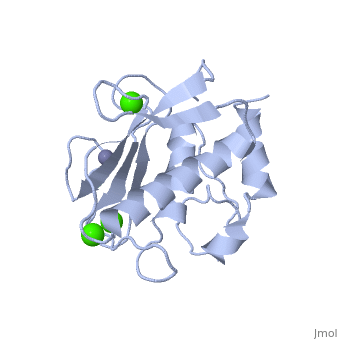User:Julie Frentzel/Sandbox 1
From Proteopedia
|
2oxu
2oxu is a human protease. It belongs to the Matrix Metalloproteinase’s family (MMPs). Theses MMPs are secreted as inactive proproteins and then activated after a cleavage by extracellular proteinases. MMPs are sorted into 17 classes depending on their localization in the cell, and on their substrates. For instance, 2Oxu is a macrophage metalloelastane indexed in MMP12 subfamily. To make things clear, it allows the migration of the macrophages in tissues by hydrolysing soluble and insoluble elastin of the extracellular matrix. This hydrolysis involves two cofactors: zinc and calcium. Zinc atoms are part of the enzyme whereas Ca2+ atoms are hydrogen bounded to the backbone of the protein. In healthy cells, 2oxu is implied in tissue remodelling and cell signalling. Because of its activity, this protein is also involved in metastasis and tumor development; that's why it is considered as an important target for drug therapies.
Structure / function relationship
Thanks to X-ray crystallography, the structure of 2oxu has been solved with 1,24 Å resolution. This enzyme consists of four alpha helix and five beta sheets organized like following.
The hydrolysis of the Substrate can be divided in four essential events:
1- Substrate's fixation
2- Substrate's cleavage
3- First fragment's release
4- Second fragment's release
The experiment was made with a collagen derived substrate to lower the enzymatic activity, so that the mechanism can be studied. In the detailed experiment implying 2oxu, a collagen derived substrate is the chosen one: Indeed, when elastin is used, its hydrolysis is so fast that no peptide cleavage mechanism can be visualized.
The substrate polypeptide sequence which is recognized by the enzyme is common to both molecules (elastin and collagen): ProGlnGly(206)IleAlaGly(209). It is known to be cleaved between Gly(206) and ILE.
Before the addition of the substrate, the active site is closed.
1) Substrate's fixation
The active site of the enzyme is composed by one Glu residue near 3 His residues which maintain a Zn2+ atom. This atom is also coordinated with three water molecules. One of them is as well bound to the Glu residue thanks to a hydrogen bond. The second Zn2+ atom is not involved in the active site. At first, the Gly 206 residue of the substrate binds the active site thanks to the Zn2+ atom. When it binds it takes the place of unstable water molecules and establishes stabilizing interactions with the active site thanks to its C terminal part. Then, the Ala 182 residue of the enzyme makes a hydrogen bond with the NH group of the substrate: this allows the substrate to enter the cavity of the catalytic site.
The rest of the protein is stabilized by 4 hydrogen bonds with the amino acid located in the cavity.
2) Substrate's cleavage
A proton of one of the three H2O moves to the Glu219 catalytic site's residue.
It creates a hydroxyl group with a high nucleophilic character.
That leads to a nucleophilic attack by zinc-coordinated hydroxyl group, on one of the carbonyl group of the substrate (Gly206).
It leads to what is called a gem-diol intermediate form of the substrate. Two fragments are then sitting in the cavity: IleAlaGly209 and ProGlnGly206.
3) First fragment's release
The fragment IleAlaGly is strongly bounded to the enzyme thanks to the bonds that have been created at the fixation's step.
But the fragment ProGlnGly just remains in place thanks to a Gly206 monodentate coordination with the Zn atom.
Then a water molecule binds this Zn atom: it becomes five coordinated, which facilitates the detachment of the ProGlnGly fragment through an associative ligand exchange mechanism.
4) Second fragment's release
IleAlaGly remains in the active site but is subjected to a rearrangement.
After the release of ProGlnGly, repulsion between positively charged zinc ion and NH3+ (coming from the peptide's cleavage) increases. It forces IlaAlaGly to enter deeper in the substrate's cavity to make hydrophobic interactions.
The transfer of this fragment prevents Ala208 to continue binding Pro208. The former bound is broken, and the fragment is no more stabilized. Finally the cavity opens and the fragment is released.
Regulation
One of the two Zn2+ ions is involved in the catalyc site to catalyse the reaction. The second Zn atom and the three Ca++ binds the enzyme to stabilized its 3D strucure. Ca++ concentration change may regulate MMP12 activity. => LINK
2Oxu possible modifications to lower its enzyme activity
Glu 219 play a very important rôle in the substrate's fixation : if it is mutated and replaced by an nonionizable residue, it lower the enzyme activity.
if the ionization of NH2 to NH3+ could be prevented, it won't lead to any repulsion with Zn : the substrate won't enter the cavity more deeply and so will remain bind to the enzyme, preventing the next binding with the next substrate.

